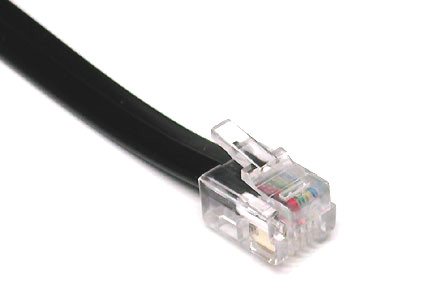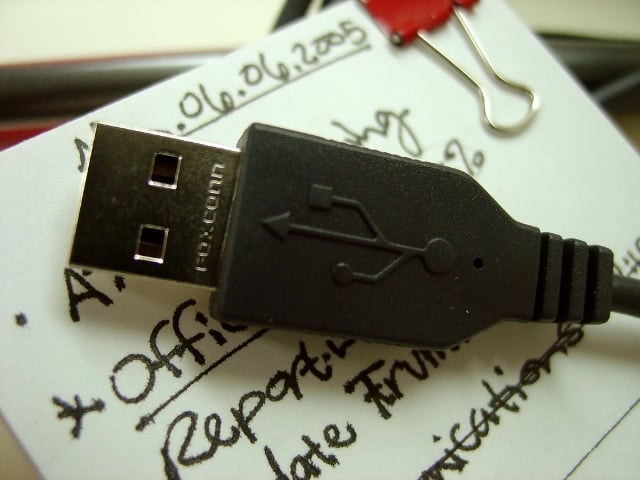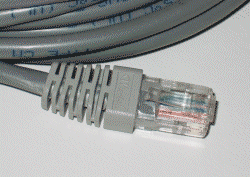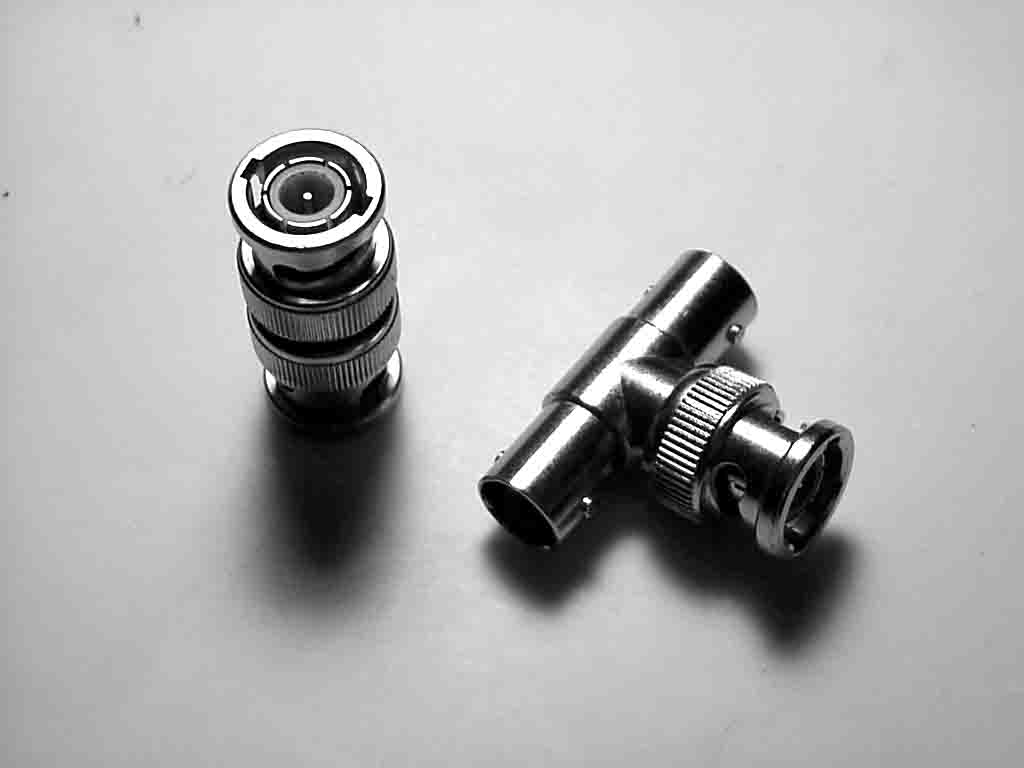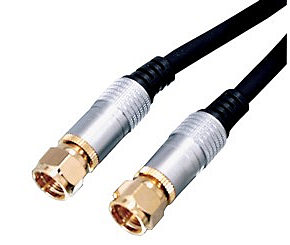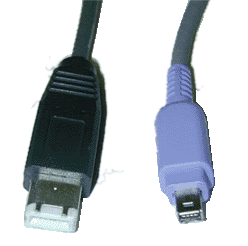Network+ Cables, Connectors Madness
-
What does UTP stand for?
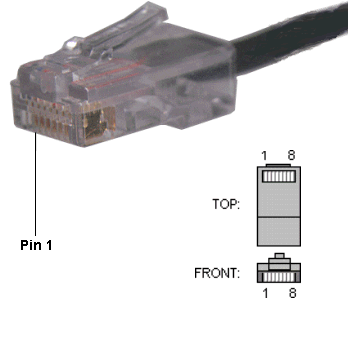
A way to familiarize yourself with network types needed for the Network+ Exam
Quiz Preview
- 2.
What connector is this?
-
BNC
-
MJ-45
-
ST
-
LC-80
-
RJ-45
Correct Answer
A. RJ-45Explanation
The correct answer is RJ-45. RJ-45 is a commonly used connector for Ethernet cables, often used for connecting computers to networks or routers. It has eight pins and is larger than the RJ-11 connector used for telephone cables. BNC, MJ-45, ST, and LC-80 are not correct answers as they do not refer to the specific connector shown.Rate this question:
-
- 3.
What does STP stand for?
Correct Answer
shielded twisted pair
Shielded Twisted Pair
Shielded twisted pairExplanation
STP stands for shielded twisted pair. It is a type of cabling that is used for transmitting data signals. The cables are made up of twisted pairs of wires, which helps to reduce electromagnetic interference. The cables are also shielded, which provides additional protection against interference from external sources. Shielded twisted pair cables are commonly used in networking and telecommunications applications to ensure reliable and high-quality data transmission.Rate this question:
- 4.
How many pairs of copper wires can be found in a Cat5e UTP Patch cable?
Correct Answer
4Explanation
A Cat5e UTP Patch cable typically consists of four pairs of copper wires. Each pair is twisted together to reduce interference and improve signal quality. Therefore, the correct answer is 4.Rate this question:
- 5.
What is this called?
-
RJ45
-
MT-RJ
-
RG-45
-
RJ11
-
RJ-58
Correct Answer
A. RJ11Explanation
RJ11 is the correct answer because it refers to a registered jack connector commonly used for connecting telephone lines. RJ11 connectors have six positions and two or four conductors, and they are typically used for single-line telephone systems. RJ45, MT-RJ, RG-45, and RJ-58 are different types of connectors used for various purposes, but they are not specifically associated with telephone lines like RJ11.Rate this question:
-
- 6.
What frequency does 802.11b WiFi operate in?
Correct Answer
2.4GhzExplanation
802.11b WiFi operates in the frequency of 2.4GHz. This frequency is commonly used for WiFi communication and is part of the unlicensed ISM (Industrial, Scientific, and Medical) band. The 2.4GHz frequency offers good range and can penetrate walls and obstacles relatively well. It is also a widely supported frequency by various devices, making it a popular choice for WiFi networks.Rate this question:
- 7.
How fast is 1000baseT?
-
Balanced copper cabling, 100Mbps
-
STP, 100Mbps
-
Twisted-pair cabling CAT-5, CAT-5e, CAT-6, or CAT-7, 200Mbps
-
Gigabit Ethernet, 1000Mbps
-
None of the above
Correct Answer
A. Gigabit Ethernet, 1000MbpsExplanation
Gigabit Ethernet is the correct answer because it provides a speed of 1000Mbps. This means that it is capable of transmitting data at a rate of 1 gigabit per second, making it significantly faster than the other options listed.Rate this question:
-
- 8.
What this called?
-
USB 3.0
-
USB 800mbps
-
Firewire
-
USB 2.0
-
IEEE 2.0
Correct Answer
A. USB 2.0Explanation
USB 2.0 is the correct answer because it is a widely used standard for connecting devices to computers. It provides faster data transfer speeds compared to its predecessor USB 1.1. USB 2.0 has a maximum transfer rate of 480 Mbps, which is significantly higher than the other options listed. USB 3.0 is a newer version with even faster speeds, but it is not mentioned in the question. Firewire is another type of connection, but it is not as commonly used as USB. IEEE 2.0 is not a valid term or standard for data transfer.Rate this question:
-
- 9.
What does MMF stand for?
Correct Answer
Multi Mode Fiber, Multi mode fiber , Multimode fiber , Multimode Fiber , multimode fiberExplanation
In networking, MMF stands for Multimode Fiber. Multimode fiber is a type of optical fiber primarily used for transmitting data over shorter distances. It has a larger core diameter compared to single-mode fiber, allowing multiple modes (or paths) of light to propagate through the fiber. This makes it suitable for applications such as local area networks (LANs) and data center interconnects.
Multimode fiber is commonly used because it is more cost-effective for shorter distance applications and supports higher data rates compared to copper cables.Rate this question:
- 10.
How fast is 10baseT?
-
100Mbps
-
30Mbps
-
10Mbps
-
2Mbps
-
1000Mbps
Correct Answer
A. 10MbpsExplanation
10baseT refers to a type of Ethernet network standard that uses twisted pair cables. It has a maximum data transfer rate of 10Mbps, which means it can transmit data at a speed of 10 megabits per second. This is a relatively slower speed compared to other Ethernet standards like 100baseT or 1000baseT, which provide higher data transfer rates of 100Mbps and 1000Mbps respectively. Therefore, the correct answer is 10Mbps.Rate this question:
-
- 11.
And this is called?
-
BNC Connector
-
LC Lucent Connector
-
ST Straight Tip
-
RJ11
-
RG-59 Connector
Correct Answer
A. BNC ConnectorExplanation
A BNC connector is a type of coaxial connector commonly used for video and audio applications. It features a bayonet-style coupling mechanism, which allows for quick and secure connections. BNC connectors are known for their excellent signal quality and are often used in professional video production and surveillance systems. They are also commonly found in RF (radio frequency) applications such as telecommunications and networking equipment.Rate this question:
-
- 12.
And how fast can data possibly travel over a Cat6 STP patch cable?
Correct Answer
10Gbps
1000MbpsExplanation
The maximum allowed length of a CAT6 cable is 100 metres when used for 10/100/1000baseT and 37 metres when used for 10GbaseT. This applies for UTP cables only. Shielded (FTP) CAT6 cables are capable of 10GbaseT up to 100m.Rate this question:
- 13.
How fast is Cat5?
-
200Mbps
-
1000Mbps
-
5.5Mbps
-
10Mbps
-
100Mbps
Correct Answer
A. 100MbpsExplanation
Cat5 refers to Category 5 Ethernet cable, which is commonly used for network connections. It has a maximum data transfer rate of 100Mbps, making it capable of transmitting data at a speed of 100 megabits per second. This makes it suitable for most home and small office networks, providing a reliable and fast connection for internet browsing, file sharing, and streaming.Rate this question:
-
- 14.
What connector can we attach to a RG-58U Coaxial Cable for Thin net?
Correct Answer
BNCExplanation
BNC connectors were commonly used on 10base2 thin Ethernet networks, both on cable interconnections and network cards, though these have largely been replaced by newer Ethernet devices whose wiring does not use coaxial cable. Some ARCNET networks use BNC-terminated coax.Rate this question:
- 15.
What frequency does 802.11g WiFi operate in?
Correct Answer
2.4GhzExplanation
802.11g WiFi operates in the frequency of 2.4GHz. This frequency is commonly used by WiFi devices and provides good coverage and penetration through walls and obstacles. The 2.4GHz frequency band allows for multiple channels to be used simultaneously, increasing the capacity for wireless connections. It is important to note that other WiFi standards, such as 802.11n and 802.11ac, can operate in both 2.4GHz and 5GHz frequency bands, offering higher speeds and less interference in the 5GHz range.Rate this question:
- 16.
What frequency does 802.11a WiFi operate in?
Correct Answer
5GhzExplanation
802.11a WiFi operates in the frequency of 5GHz. This frequency band provides a higher data transfer rate compared to the 2.4GHz band used by other WiFi standards. The 5GHz frequency offers more available channels and less interference from other devices, resulting in a more stable and faster wireless connection. This makes it suitable for applications that require high-speed and reliable wireless connectivity, such as video streaming and online gaming.Rate this question:
- 17.
What distance can data over a 1000BaseT travel?
-
200 meters
-
150 meters
-
1000 meters
-
100 meters
-
400 meters
Correct Answer
A. 100 metersExplanation
Data over a 1000BaseT can travel a maximum distance of 100 meters. This is because 1000BaseT is a type of Ethernet technology that uses twisted pair cables, and the maximum distance that can be supported by this technology is 100 meters. If the distance exceeds 100 meters, signal degradation and loss may occur, resulting in unreliable data transmission.Rate this question:
-
- 18.
How fast can data travel over Cat3 UTP?
-
200Mbps
-
100Mbps
-
10Mbps
-
2Mbps
-
1.5Mbps
Correct Answer
A. 10MbpsExplanation
Cat3 UTP (Unshielded Twisted Pair) is a type of Ethernet cable commonly used for voice and data transmission. It has a maximum bandwidth of 16MHz, which limits its data transmission speed. The correct answer of 10Mbps aligns with the maximum data rate that Cat3 UTP can support. This means that data can travel at a speed of 10 Megabits per second over Cat3 UTP.Rate this question:
-
- 19.
Again, in terms of networking, what does "ST" as in ST Connector stand for?
Correct Answer
Straight Tip
Straight tip
straight tipExplanation
Straight Tip fiber optic connectorRate this question:
- 20.
IEEE 802.11a WIFI operates at this speed:
Correct Answer
54MbpsExplanation
IEEE 802.11a WiFi operates at a speed of 54Mbps. This standard uses the 5 GHz frequency band and provides higher data rates compared to previous WiFi standards. The 54Mbps speed allows for faster data transfer and better performance, making it suitable for applications that require high bandwidth, such as streaming high-definition videos or online gaming.Rate this question:
- 21.
IEEE 802.11b WIFI operates at which speed?
Correct Answer
11Mbps , 11Explanation
IEEE 802.11b WIFI operates at a speed of 11Mbps. This means that the maximum data transfer rate for this type of WIFI is 11 megabits per second.Rate this question:
- 22.
How fast can data travel over a Cat5e STP patch cable? Example: 20Mbps, or 50Mbps 10Gbps etc.
Correct Answer
1000Mbps
1GbpsExplanation
The correct answer is 1000Mbps or 1Gbps. This refers to the maximum data transfer rate that a Cat5e STP patch cable can support. Mbps stands for megabits per second, and Gbps stands for gigabits per second. Therefore, the cable can transmit data at a speed of 1000 megabits per second or 1 gigabit per second.Rate this question:
- 23.
If i want to push data at 10Gps up to 200 meters can i use SMF?
Correct Answer
No
no
nExplanation
The given answer "No,no,n" suggests that it is not possible to use SMF (Single Mode Fiber) to push data at 10Gps up to 200 meters. SMF typically supports longer distances, ranging from kilometers to tens of kilometers, rather than just 200 meters. Therefore, other types of fiber optic cables, such as Multi-Mode Fiber (MMF), may be more suitable for this specific requirement.Rate this question:
- 24.
In terms of network media, what does SMF refer to?
Correct Answer
Single Mode Fiber, Single mode optical fiberExplanation
SMF refers to Single Mode Fiber. Single mode fiber is a type of optical fiber that allows only one mode of light to propagate. It has a smaller core diameter compared to multimode fiber, which enables it to transmit signals over longer distances with less attenuation. The correct answer is Single Mode Fiber, Single mode fiber, single mode fiber.Rate this question:
- 25.
What connector is this?
-
RJ-45
-
BNC
-
ST
-
LC
-
MT-RJ
Correct Answer
A. MT-RJExplanation
MT-RJ is a type of connector commonly used in fiber optic networks. It stands for Mechanical Transfer Registered Jack and is designed to connect two fibers together. It has a small form factor and combines both the transmitter and receiver into a single connector, allowing for easier installation and maintenance. MT-RJ connectors have a rectangular shape with two fibers aligned side by side, and they use a push-pull mechanism for insertion and removal. They are often used in data centers and telecommunications networks for high-speed data transmission.Rate this question:
-
- 26.
What Frequency does 802.11 Legacy operate in?
Correct Answer
2.4GhzExplanation
802.11 Legacy operates in the frequency of 2.4GHz. This frequency is commonly used for Wi-Fi networks and is the standard frequency for older Wi-Fi devices. The 2.4GHz frequency provides good range and is able to penetrate walls and other obstacles relatively well. However, it is also a crowded frequency band, which can lead to interference from other devices such as microwaves, cordless phones, and Bluetooth devices.Rate this question:
- 27.
What surrounds the 4 pairs of twisted copper wires in a Cat5e STP patch cable?
-
Plastic
-
Antistatic Shieth
-
Plenum Coating
-
Thin Metal Shielding
-
Anti Static Plastic Shielding
Correct Answer
A. Thin Metal ShieldingExplanation
wisted pair cables are often shielded in attempt to prevent electromagnetic interference. Because the shielding is made of metal, it may also serve as a ground. However, usually a shielded or a screened twisted pair cable has a special grounding wire added called a drain wire. This shielding can be applied to individual pairs, or to the collection of pairs. When shielding is applied to the collection of pairs, this is referred to as screening. The shielding must be grounded for the shielding to work.Rate this question:
-
- 28.
IEEE 802.11g WIFI operates at what speed?
Correct Answer
54MbpsExplanation
IEEE 802.11g WIFI operates at a speed of 54Mbps. The "g" in IEEE 802.11g refers to the wireless standard that was introduced as an improvement over the previous "b" standard. This upgrade allowed for faster data transmission rates, with a maximum speed of 54Mbps. This speed is suitable for most common internet activities such as web browsing, email, and streaming videos. However, it may not be sufficient for more bandwidth-intensive tasks such as online gaming or HD video streaming.Rate this question:
- 29.
CableAnd how many meters can data possibly travel over a Cat6 STP patch cable on 10GBaseT?
Correct Answer
100, 100 meters, 100mExplanation
The maximum allowed length of a CAT6 cable is 100 metres when used for 10/100/1000baseT and 37 metres when used for 10GbaseT. This applies for UTP cables only. Shielded (FTP) CAT6 cables are capable of 10GbaseT up to 100m.Rate this question:
- 30.
What frequency does 802.11n WiFi operate in?
Correct Answer
2.4GhzExplanation
802.11n WiFi operates in the frequency of 2.4GHz. This frequency is commonly used by WiFi devices because it offers a good balance between range and speed. The 2.4GHz frequency band allows for better penetration through walls and other obstacles, making it suitable for use in homes and offices. Additionally, many devices such as smartphones, laptops, and smart home devices support this frequency, making it a widely adopted standard for WiFi communication.Rate this question:
- 31.
And how many meters can data possibly travel over a Cat6 UTP patch cable on 10GBaseT?
Correct Answer
37 - 32.
What is this cable called?
-
BNC
-
FC Fire Optic
-
F-Type
-
Thinnet
-
IEEE 1394
Correct Answer
A. F-TypeExplanation
The correct answer is F-Type. The F-Type cable is a coaxial cable commonly used for connecting television antennas, cable television feeds, and satellite signals. It is characterized by its screw-on connector, which provides a secure and reliable connection. The other options, BNC, FC Fire Optic, Thinnet, and IEEE 1394, are different types of cables used for various purposes, but they are not specifically referred to as F-Type cables.Rate this question:
-
- 33.
What would this be called?
-
IEEE 1284
-
IEEE 1395
-
IEEE 802.11
-
IEEE Firewire 200
-
IEEE 1394
Correct Answer
A. IEEE 1394Explanation
IEEE 1394 is the correct answer because it refers to the Institute of Electrical and Electronics Engineers (IEEE) standard for a high-speed serial bus interface. It is commonly known as Firewire and is used for connecting devices such as computers, digital cameras, and external hard drives. IEEE 1284 and IEEE 802.11 are standards for parallel and wireless networking respectively, while IEEE Firewire 200 is not a recognized standard.Rate this question:
-
- 34.
And what might RG-58U be used for?
-
Audio & Video HDTV
-
10Base2 Thinnet
-
Gigabit Ethernet
-
Telephone wires
-
Morse Code
Correct Answer
A. 10Base2 ThinnetExplanation
RG-58U is a type of coaxial cable that is commonly used for 10Base2 Thinnet networking. 10Base2 Thinnet is an Ethernet standard that uses RG-58U coaxial cable to connect computers in a local area network. This type of cable is specifically designed for transmitting data at a rate of 10 megabits per second over short distances. It is not used for audio and video transmission, gigabit Ethernet, telephone wires, or Morse Code.Rate this question:
-
- 35.
In the same way, SC stands for Square Connector. It also stands for
Correct Answer
Subscriber ConnectorExplanation
Subscriber/Square ConnectorRate this question:
- 36.
What frequency does Bluetooth operate in?
Correct Answer
2.45GhzExplanation
Bluetooth operates in the frequency of 2.45GHz. This frequency was chosen for Bluetooth technology because it is an unlicensed frequency band globally, meaning that it can be used without the need for obtaining a license. Additionally, the 2.45GHz frequency has good penetration capabilities and is less prone to interference from other devices. This frequency allows Bluetooth devices to communicate wirelessly and reliably over short distances.Rate this question:
- 37.
Which of the following Protocols operate on the Application layer of the OSI Model?
-
RARP
-
NTP
-
SCTP
-
TFTP
-
NetBEUI
Correct Answer(s)
A. NTP
A. TFTPExplanation
NTP (Network Time Protocol) and TFTP (Trivial File Transfer Protocol) both operate on the Application layer of the OSI Model. NTP is used for synchronizing the clocks of network devices, ensuring accurate timekeeping. TFTP is a simple file transfer protocol used for transferring files between clients and servers. RARP (Reverse Address Resolution Protocol) operates on the Network layer, SCTP (Stream Control Transmission Protocol) operates on the Transport layer, and NetBEUI (NetBIOS Extended User Interface) operates on the Session layer.Rate this question:
-
- 38.
How far can i push data with Multimode fibre at 10Gps?
Correct Answer(s)
550 Meters
550 meters
550mExplanation
In general, then, multimode fiber continues
to be the most cost-effective
choice for enterprise applications up
to 550 meters. Single-mode fiber is
best used for distances exceeding
550 meters.Rate this question:
- 39.
Wireless. 802.11 Legacy operates at what speed? Example: 200Mbps.
Correct Answer(s)
2MbpsExplanation
802.11 Legacy operates at a speed of 2Mbps.Rate this question:
- 40.
Which of the following Protocols operate on the Application layer of the OSI Model?
-
HTTP
-
ZIP
-
IPX
-
WiFi
-
DNS
Correct Answer(s)
A. HTTP
A. DNSExplanation
HTTP and DNS are both protocols that operate on the Application layer of the OSI Model. HTTP (Hypertext Transfer Protocol) is used for transferring hypertext messages, such as those used in web browsing. DNS (Domain Name System) is used for translating domain names into IP addresses, allowing users to access websites using human-readable names instead of numerical IP addresses. ZIP, IPX, and WiFi are not protocols that operate on the Application layer. ZIP is a file compression format, IPX is a network protocol used by Novell NetWare, and WiFi is a wireless networking technology.Rate this question:
-
- 41.
What speed does IEEE 802.16 WIMax operate at?
Correct Answer(s)
75MbpsExplanation
IEEE 802.16 WiMax operates at a speed of 75Mbps. This refers to the maximum data transfer rate that can be achieved using this wireless communication technology. WiMax is designed to provide high-speed internet access over long distances, making it suitable for areas where traditional wired connections are not feasible or cost-effective. With a speed of 75Mbps, users can enjoy fast and reliable internet connectivity for various applications such as streaming, online gaming, and large file downloads.Rate this question:
- 42.
Just how far in meters can we push data through SMF (Single Mode Fibre) at 1Gbps?
Correct Answer(s)
1km
1 Kilometer
1 kilometer
1000 Meters
1000 metersExplanation
Although single-mode fiber has
advantages in terms of bandwidth and
reach for longer distances (> 1 kilometer
at 1 Gb/s), multimode fiber easily
supports most distances required
for premises and enterprise networks.
In fact, multimode fiber can support
10 Gb/s transmission to 550 meters
for long backbone and even short
campus runs.Rate this question:
- 43.
What is RG-59U? used for?
-
Radio Frequencies
-
Telephones
-
Audio & Video - like VCR's
-
TV's
-
10Base2 Thinnet
Correct Answer(s)
A. Audio & Video - like VCR's
A. TV'sExplanation
RG-59U is a type of coaxial cable that is commonly used for transmitting audio and video signals. It is specifically designed for applications such as connecting VCRs and TVs, where high-quality audio and video transmission is required. This cable is capable of carrying both analog and digital signals, making it suitable for various audio and video devices.Rate this question:
-
- 44.
IEEE 802.11n WIFI operates at this speed:
Correct Answer(s)
540MbpsExplanation
IEEE 802.11n WIFI operates at a speed of 540Mbps. This standard, also known as Wi-Fi 4, introduced significant improvements compared to its predecessors. It utilizes multiple antennas and advanced modulation techniques like MIMO (Multiple Input Multiple Output) to achieve higher data rates. The 540Mbps speed refers to the maximum theoretical throughput that can be achieved under ideal conditions. However, the actual speed experienced by users may vary depending on factors such as distance from the access point, interference, and network congestion.Rate this question:
- 45.
On the same subject we have a "LC" connector in fiber optics referred to as: (Select all that apply)
-
LAN (Opticial) Connector
-
Local Connector
-
Lucent Connector
-
Lambert Corp Connector
-
Lucent FFS
Correct Answer(s)
A. Local Connector
A. Lucent ConnectorExplanation
Developed by Lucent, now Alcatel LucentRate this question:
-
- 46.
Which of the following Protocols operate on the Application layer of the OSI Model?
-
SQL
-
802.11b/g/n
-
Telnet
-
Quicktime
-
LDAP
Correct Answer(s)
A. Telnet
A. LDAPExplanation
Telnet and LDAP are protocols that operate on the Application layer of the OSI Model. Telnet is a network protocol that allows users to remotely access and control a computer over a network. LDAP (Lightweight Directory Access Protocol) is a protocol used to access and manage directory information services. SQL is a language used to manage and manipulate databases, 802.11b/g/n is a set of wireless networking standards, and Quicktime is a multimedia framework. Therefore, Telnet and LDAP are the correct answers as they both operate on the Application layer.Rate this question:
-
- 47.
Which of the following Protocols operate on the Application layer of the OSI Model?
-
JPEG
-
MPEG
-
File & Print
-
NBP
-
SMTP
Correct Answer(s)
A. File & Print
A. SMTPExplanation
The protocols that operate on the Application layer of the OSI Model are File & Print and SMTP. The Application layer is responsible for providing network services to the user applications. File & Print protocol allows users to share files and printers over a network, while SMTP (Simple Mail Transfer Protocol) is used for sending and receiving email messages. JPEG and MPEG are compression standards used for image and video files, respectively. NBP (Name Binding Protocol) is a protocol used in AppleTalk network architecture.Rate this question:
-
- 48.
For Infrared, from what speed - speed can we achieve? Example: 25Mbps-50Mbps, or 75Mbps-10Mbps.
Correct Answer(s)
100kbps-16MbpsExplanation
Infrared technology can achieve speeds ranging from 100kbps to 16Mbps. This means that data can be transmitted wirelessly at a minimum speed of 100kbps and a maximum speed of 16Mbps using infrared signals.Rate this question:
- 49.
What frequency range does Infrared operate on? Example: 2Ghz-5Ghz, or 25Ghz-5000Thz.
Correct Answer(s)
100Ghz-1000ThzExplanation
Infrared operates on a frequency range of 100Ghz-1000Thz.Rate this question:
Quiz Review Timeline (Updated): Jun 19, 2024 +
Our quizzes are rigorously reviewed, monitored and continuously updated by our expert board to maintain accuracy, relevance, and timeliness.
-
Current Version
-
Jun 19, 2024Quiz Edited by
ProProfs Editorial Team -
Jan 07, 2010Quiz Created by
Accuratelifestyl
 Back to top
Back to top



